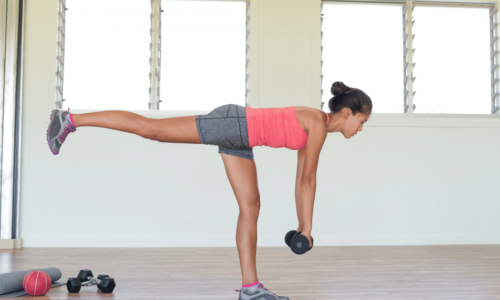Are you taking advantage of the lighter evenings by running? Part of a running club? Training for a race? If the answer is Yes … keep reading!
Strength training is an absolute must for all runners – whether you are running for fun or training for a marathon.
Here’s why…
By strengthening certain muscle groups, it not only helps prevent injury but increases running efficiency, which means your muscles learn to use less energy, enabling you to run for longer and at a faster pace.
To help you get started and build up those all important quads, glutes and hamstrings, our physiotherapist Dylan has put together his top strength building exercises.
1. Goblet Squat
1. Hold a dumbbell or kettlebell by one of the bell ends with both hands under your chin
2. Stand with feet shoulder-width apart
3. Lower into a squat as if going to sit down on a chair, keeping your lower back in its natural arch.
4. Push through your heels and squeeze your glutes as you come back up.
5. Perform three sets of 8–12 reps.
Why is this exercise so great?!
An excellent exercise for the glutes and quads allowing you to perform a deep squat. Squatting develops your entire lower body and is arguably the best exercise for building running strength and speed.
Top Tip:
Using a bench or chair will help you keep the correct form while squatting. Just starting out – perform without a weight and add resistance gradually.
2. Split Squat
1. Start in a split leg position, with one leg forward and one leg back
2. Flex your knees and lower your hips, until the back knee is just above the floor
3. Stand back up and return to the starting position
4. Repeat and perform three sets of 8–12 reps.
Why is this exercise so great?!
The Split Squat is one of the best exercises for runners. We all tend to have a dominant leg (one leg stronger than the other) and performing a split squat allows you to focus one one leg at a time – strengthening the glutes, quads and hamstrings – all key muscles for runners
Top Tip:
Focus on maintaining good technique throughout all sets and repetitions. Stop if you feel your technique is compromised. If you are beginner perform with bodyweight until competent.
3. Single Leg Step Up
1. Step onto the bench with one foot, keeping your knee bent while keeping the other on the floor
2. Lean forward a little, and drive through the heel of your foot to pull yourself up straightening the leg on the bench
3. Now lower back down with a controlled movement only touching the toe of your foot on the floor.
4. Perform three sets of 8–12 reps and repeat the movement with the other leg.
Why is this exercise so great?!
All runners can benefit from single-leg exercises – they are great for highlighting any muscle imbalances and improving your balance and core stability whilst working the glutes. quads and hamstrings.
Top Tip:
If you’re just starting out, all you need is your body weight – but you can easily make them harder by adding dumbbells, a kettlebell or by increasing your step height.
4. Single Leg Reverse Dead Lift (RDL)
1. Start with your feet together, with your hands on hips or at your sides. Shift your weight to your left leg, knee slightly bent.
2. Hinge at your hips to bring your chest down while raising your right leg behind you until your body is in a line from your head to your right foot. Reverse back to the starting position and repeat (8 – 12 reps should do it) then switch sides.
Why is this exercise so great?!
Not only does this build muscle and strength in your hamstrings and glutes, single-leg deadlifts also improve coordination and balance (so you’ll work your core muscles too!).
Top Tip:
Keep the back flat and core tight. Once you can do this competently using body strength, add a dumb bell.
5. Heel Raise
1. Stand on both feet. Use a wall or chair for balance.
Lift one foot off the floor. With the other foot, raise the heel off the ground keeping a hand on the wall/chair for balance. Go all the way up and down!
2. Repeat (8 – 12 reps should do it) then switch sides.
Why is this exercise so great?!
Calf weakness is a common issue in runners and can lead to pain and injuries in the foot, ankle and lower leg. The heel raise can help eliminate pain and protect against future injury.
Top Tip:
Because the heel raise exercise is so simple, it’s easy to rush it. Maintaining a slow and controlled movement is important.
6. Band Walks
1. Loop the band around feet. Legs should be hip-width apart and bent at the knee.
2. Walk side-wards using small steps always keeping the feet hip width apart at all times, ensuring your knees remain bent.
3. Repeat (8 – 12 reps should do it) then switch sides.
Why is this exercise so great?!
Resistance bands help to boost your power and strength in your calves, quads, and glutes. Strengthening these and other muscles will help you run more efficiently and more powerfully.
Top Tip:
Make sure to keep tension on the resistance band while stepping!
How often should I perform these exercises?
The ideal would be two or three sessions of strength training a week.
If you have never strength trained before, treat the above as bodyweight exercises for the first 2-3 weeks and gradually add weights.
If you experience any pain doing these exercises or whilst running – stop and come and see us to see how we can help.
Book your physiotherapy appointment
For more information or a chat contact us on 0121 270 6045




